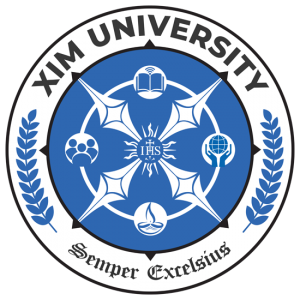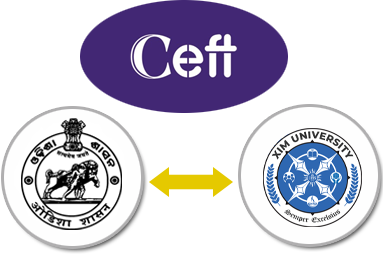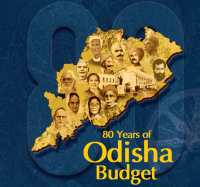Working Papers
- State Finance to bleed further in 2020: An inter-state analysis
- Trends in Components of Revenue Receipts in Odisha: 2000-01 to 2016-17
- Study of Revenue Implications of 14th Finance Commission Recommendations and Union Budget FY 2015-16 on Odisha
- a. Objective- the recommendation of finance commission (FC) broadly comprises of tax devolution from Centre to States, non-plan grant & loan to State, central assistance for States & UTs and assistance for central and centrally sponsored schemes.
- Estimation of Base Line and Optimal Credit Deposit Ratio in Odisha
- a. Objective- To estimate optimal (desired level) credit to deposit (C-D) ratio and per capita credit of Odisha for 2019-20. All non-special category of states are analysed to benchmark the optimal CD ratio for Odisha.
- Estimation of Optimal Commercial Banks Agriculture Credit in Odisha
- a. Objective- To estimate desired level of credit to deposit (C-D) ratio and per capita credit in agriculture sector of Odisha for 2019-20.
- Motor Vehicle (M.V) Tax Effort Index of States in India with special emphasis on Odisha
- a. Objective – This study attempts to estimate tax effort index of Motor Vehicles (M.V Tax) of states (NSC) in India. The M.V Tax effort index of Odisha is compared with other Non-special category (NSC) states.
- Migrating to above poverty line in Indian States
- a. Objective – The study seeks to find the percentage of people migrated from below poverty line to above poverty line in 17 non-special category states (NSC) states of India.
- Determinants of Non-Performing Loans in India: A System GMM Panel Approach
- a. Objective – The study investigates the determinants of Non-Performing Loans (NPLs) of the Indian banking system for the period 2000-01 to 2015-16.
- Nexus between Government Spending and Economic Growth: Evidence from sub-national Governments in India
- a. Objective – This study examines the relationship between government spending and economic growth by considering other some control variables like institutional credit and commercial electricity consumption, for a panel of 14 major sub-national governments in India for the period from 1980-81 to 2013-14.
- State Level Power Sector Reforms in India
- a. Objective – This paper empirically establishes that lower AT&C losses will raise the revenue realization per unit (RPU).
- The Long-run Causal Nexus between Expenditure in Social Services Sector and Economic Services Sector: A comparative analysis between National and Sub-National Government
- a. Objective – The study attempts to analyze the long run association and the causal nexus between expenditure in social services and economic sector both in Indian context as well as in the context of Odisha.
- Impact of Non-Tax Revenue on Revenue Expenditure in Sub-National Public Finance in Economic Sector
- a. Objective – The study examines have examined the effect of per capita non-tax revenue on the per capita revenue expenditure in economic service sector in case of 15 NSC sub- national governments of India for the period 2010-11 to 2014-15.
- The Nexus between Fiscal Decentralization and Economic Growth: Evidence from Sub-National Governments in India
- a. Objective – This paper uses Panel Vector Auto Regression to examine the impact of financial decentralization on economic growth in 17 sub-national governments in India taking data from 2000-01 to 2014-15.
- Relationship between Electricity Energy Consumption and GDP: Evidence from India
- a. Objective – This paper examines whether electricity energy consumption drives economic growth or vice versa in the Indian context using annual data covering the period from 1970-71 to 2011-12.
- Impact of Public Debt on Economic Growth: Evidence from Indian States
- a. Objective – This study examines the impact of public debt on economic growth by taking control variables like institutional credit and commercial electricity consumption.
- Fiscal Performance Index of the States in India
- a. Objective – This study makes an empirical analysis of state finances in India by recognizing the changes that have occurred in many exhaustive lists of fiscal parameters.
- Does FRBM Act influence Fiscal deficit-Growth nexus in India?
- a. Objective – This paper examines the link between economic growth and fiscal deficit in India for the periods between 1970-71 to 2016-17 and 1970-71 to 2003-04.
- Fiscal Landscape in Odisha: An analysis of Deficits and Expenditures
- a. Objective – This study examines the paradigm shift in the fiscal landscape of Odisha during the period spanning from 1980-81 to 2014-15.
- Cointegration between Government Expenditure and Revenue
- a. Objective – The study examines the nexus between tax revenues of the government and public expenditure in India using Johensen- Juselius cointegration methodology during 1980-81 to 2013-14.
- An empirical analysis of effect of public debt on economic growth in India in the post-reform era
- a. Objective – The paper examines causal nexus between public debt and economic growth for 15 NSC states of India for the period 1991-2015 using DumitrescuHurlin causality test.
- Causal Nexus between Billing Efficiency and Economic Growth in India: An Analysis Using Vector Autoregression
- a. Objective – This paper attempts to examine the Vector Autoregression (VAR) based Granger causality between billing efficiency and growth rate of per capita GDP of India using annual time series data for the period 1970-71 to 2014-15.
- Does the Union Budget 2016-17 reflect the true spirit of Fiscal Federalism?
- a. Objective – The study examines the rise or fall in transfers to the states.
- Bank Credit and Economic Growth: An empirical Evidence from Indian States
- a. Objective – This study adds to the existing credit-growth nexus literature by analyzing the causal nexus between total credit and growth across the sub-national level in India and also examining the effect of credit on economic growth.
- Threshold level of Fiscal Deficit and Economic Growth: Revisiting FRBMA Limit in Indian States
- a. Objective – This paper examines the relationship between fiscal deficit and economic growth from 2001-2014 in Indian states.
- A Note on Impact of Demonetization on Odisha
- a. Objective – Sector wise Impact analysis.
- Is Fiscal Policy Pro-Cyclical or Counter-Cyclical? Evidence from India
- a. Objective – This study investigates the cyclicality of fiscal policy in India at the Centre, State, and combined Centre-State level by employing three alternative methods. The period of analysis extended from 1970-71to 2013-14.
- Revisiting the Financial Year in India
- a. Objective – This study attempts to analyze the issue of changing financial year in India considering the international practices.
- Comparative Analysis of Central Taxes Transfer to Non-Special Category States
- a. Objective – The study compares the central transfer to states recommended by different finance commissions.
- Evidence of Wagner’s Law in Odisha
- a. Objective – The study examines the validation of Wagner’s law as well as shows the impact of both plan and non-plan expenditure on economic growth of Odisha.
- Analysis of Finance Commissions Transfers to Odisha: From GSDP Perspective
- a. Objective – The study investigates the trend analysis of Finance Commissions transfers with respect to Gross State Domestic Product (GSDP) of Odisha.
- Impact of Fourteenth Finance Commission’s Recommendations on the Union Budget 2015-16: Preliminary Evidence
- a. Objective – This study examines the impact of FFC on Union Budget 2015-16. The hypothesis of increase in unconditional transfers to states is tested by capturing compositional shift in Union Budget from FY 2010-11(BE) to FY 2015-16(BE).
- Physical Infrastructure Index for Govt. Schools of Odisha: An Analysis using Principal Component Analysis
- a. Objective – The study attempts to construct a physical infrastructure index for government schools of Odisha using principal component analysis (PCA).
- A Comparative Analysis of Inter-State Expenditure Ratios
- a. Objective – This study explores the trends in revenue and capital expenditures for fifteen State Governments during 1980-81 to 2014-15.
- Study of Revenue Implications of 14th Finance Commission Recommendations and Union Budget FY 2015-16 on Odisha
- a. Objective – The study examines the impact of the recommendations of FFC and Union Budget 2015-16 on the total Central Transfer (both Share tax and Grants from Centre) to Odisha at a disaggregated level.
- The Long-run Causal Nexus between Expenditure in Social Services Sector and Economic Services Sector:
- a. Objective – The study attempts to analyze the long run association, and to examine the causal nexus between the expenditure in social services and the expenditure in economic services both in Indian context as well as for Odisha.
- Efficiency in Value Added Tax in Sub National Governments in India: An Empirical Analysis
- a. Objective – Objective is to develop VAT efficiency model for the sub national governments in India and to identify the significant factors that impacts VAT efficiency at sub-national level in India.
- Analysis of the State Finances (Annual)
- a. Objective – For more realistic assessment of States’ fiscal position and its implications on overall economic growth in the State, report on “Analysis of the State Finances of Odisha” is prepared every year.
- Revenue sharing with Urban and Rural Bodies by both State and Centre
- a. Objective – To compute formula based devolution, Assignment of Taxes and fund requirements of sector specific needs.
- Determinants of yield on SDL in Auction Market
- a. Objective – To identify the variables which impact yield and coefficient of these relevant variables.
- Exploring the Possibility of availing Multilateral Development Assistance in Local Currency for Externally Aided Projects being executed by the State Government
- a. Objective – Cost Benefit Analysis as compared to loan denominated in INR.
- Capital Multiplier and Revenue Expenditure Multiplier on GSDP of Odisha
- a. Objective – To find out the financing pattern of the expenditure.
- The Implication of Goods and Services tax on the revenue position of the State.
- a. Objective – To estimate the impact of GST on state’s revenue.
- Analysis of Debt Burden and Debt Sustainability of Odisha from FY 2005-06 to FY 2018-19.
- a. Objective – To study the relative position of Odisha in terms Debt-GSDP ratio, per capita debt, debt servicing ratio during the post-FRBMA period i.e., from 2005-06 to 2018-19.To quantify the sustainable level of debt ratio for Odisha.
- Estimation of Debt Management Index of the States in India.
- a. Objective – To Compute Efficiency Index of Debt Management of States in India (18 States).
- An empirical analysis of shortfall in GST revenue: Analysis of Odisha
- a. Objective – The study estimate the loss in revenue on account of implementation of GST in Odisha, analysing top 100 dealers and change in tax rates.
- Study report accepted by the Central Fifteenth Finance Commission on “Projection of Tax Revenue on Petroleum Products and Sales Tax and State’s Own Tax Revenue (SOTR) Effort Analysis of States in India”.
- a. Objective – To calculate tax effort of state’s own tax revenue (SOTR), sales tax exclusive of petroleum tax revenue and sales tax inclusive of petroleum tax revenue of Indian states 2012-13 to 2016-17. This study projects Petroleum Tax Revenues for the states for the period 2019-20 to 2024-25. This study also examines the efforts made by seventeen general category states in India to reform their tax systems with the intention of augmenting revenues.
- GST: A State-wise Analysis of Revenue Shortfall and Return Filing (July 2017-May 2019).
- a. Objective – The study makes an inter-state analysis of trends in due date and till date Return Filing and shortfall in revenue, with special focus on Odisha.
- GST: Circle-wise Analysis of Return Filing Status of GSTR-3B in Odisha (July 2017-September 2019)
- a. Objective – To ascertain major revenue-generating commodities for the State Government. To analyze whether Odisha is a consuming or exporting State.
- E-way Bill Analysis of Odisha
- a. Objective –To ascertain major revenue regenerating commoditises for the state government using data on Inward and Outward Supply during July 2017-September 2019.
- Agriculture and Allied activities Index of Odisha 2020
- a. Objective – To analyze the performance of Agriculture and Allied activities in post-COVID period of Odisha; from April – July 2020 by constructing a composite Index.
- Analysis of Emergency Credit Line Guarantee Scheme (ECLGS) in Odisha for August 2020
- a. Objective – To analyze the bank credit status under ECLGS to the MSME and small business for their working capital needs, operational liabilities and restart business impacted due the COVID-19 crisis.
- Assessing Fiscal Risks-Odisha’s Experience
- a. Objective – To provide an analytical report on the Odisha’s experience in managing fiscal risk that are arising from macroeconomic, natural disaster, foreign currency fluctuations, and international commodities prices.
- First Quarter Analysis of State Finance 2020-21
- a. Objective- The First-Quarter (Q1) Financial Analysis 2020-21 of the Government of Odisha depicts the financial position of the Government by capturing both Revenue & Capital accounts and the accounts of the Public Debt and liabilities.
- Fiscal forbearance: Review of 15th Finance Recommendation
- a. Objective- The study examines the implications of recommendation of 15th Finance Commission on state government’s finances.
- Fiscal Strategy Report of Odisha 2020 (Finance Department, Government of Odisha, IMF-SARTTAC and CEFT)
- a. Objective – This Fiscal Strategy Report (FSR) has been brought out as an outcome of the Medium-Term Fiscal Framework (MTFF). It will provide a 3-year economic and fiscal outlook, and a discussion about how the State is planning to allocate its resources for FY 2020-21 to FY 2023-24.
- Monthly Fiscal Monitor Report of Odisha up to September 2020
- a. Objective- Fiscal monitor report depicts the monthly financial position of the Government by capturing both Revenue & Capital accounts and the accounts of the Public Debt and liabilities.
- Odisha’s Economic Outlook on Elderly during Pandemic
- a. Objective- The objective of the study is to understand the morbidity and health status of the elderly population of Odisha and its linkage with COVID-19.
- Reports on Result of Yield/Price Based Auction of State Development Loans of State Governments up to 28th October 2020
- a. Objective- To examine the yield spread of SDL vis-à-vis G-sec 10 year bond.
- Odisha State Economic Index
- a. Objective- To understand the overall impact on Odisha’s economy, a composite State Economic Index is constructed by taking seven no. of state specific high frequency (monthly) indicators. The index has been calculated up to September 2020.
- Status Paper on Government Guarantee of Odisha FY 2019-20
- a. Objective- The objective is to study the debt position of the Government of Odisha by capturing net loans & advances from the Central Government, net internal borrowing and net borrowing from State Provident Fund. Net internal borrowing consists of borrowing from NABARD, LIC, National Co-operative Development Corporation (NCDC), Special Securities issued to NSSF of Central Government, State Development loan (market borrowing) and borrowing from other institutions.
- Status Paper on Odisha Government Debt FY 2019-20
- a. Objective- The objective is to study the debt position of the Government of Odisha by capturing net loans & advances from the Central Government, net internal borrowing and net borrowing from State Provident Fund. Net internal borrowing consists of borrowing from NABARD, LIC, National Co-operative Development Corporation (NCDC), Special Securities issued to NSSF of Central Government, State Development loan (market borrowing) and borrowing from other institutions.
- The recent issues in shortfall in GST compensation and its impact on Odisha
- a. Objective- To examine the suitable loan options for the state to meet shortfall in GST compensation. The state was asked to choose to any one for borrowing out of two options.
- Weekly Sectoral Bank Credit Analysis of Odisha for August 2020
- a. Objective- Objective-To analyse the credit growth in agriculture, MSME and SHGs on a weekly basis.
- Mid-Year Analysis of State Finance 2020-21
- a. Objective-The Mid-Year (H1) Financial Analysis 2020-21 of the Government of Odisha depicts the financial position of the Government by capturing both Revenue & Capital accounts and the accounts of the Public Debt and liabilities.
- Gap Analysis of Projected GST Revenue and Protected Revenue in Odisha
- a. Objective – The study estimate the gap between Projected GST Revenue and protected Revenue for the period from FY 2017-18 to FY 2029-30, keeping in mid the end of GST Compensation in June 2022.
- Fisheries and Animal Resource Index of Odisha 2020
- a. Objective – To analyze the performance of fisheries and Animal Resources post-COVID period; from April – July 2020 by constructing a composite Index.
- Improving Quality of Expenditure in Odisha
- a. Objective- The study calculate quality of expenditure and major intervention undertaken to improve quality of expenditure in the state.
- Estimation of mining royalty of mineral ores of Odisha
- a. Objective – The study estimate royalty to be paid on Iron ore, Manganese ore, Bauxite, chromite and lime stone to Government of Odisha
- Estimating the determinants of state’s own revenue potential and calculation of Revenue Effort of the states in India
- a. Objective – To estimate potential factors that potentially influence state own revenue and calculate state’s tax effort in SOR in Odisha from 1990-91 to 2017-18. The 17 non-special category of states are analysed in the estimation of revenue potential and revenue effort.
- Estimating Determinants of Goods Tax of Odisha
- a. Objective – To estimate factors that influences goods tax (sales tax) in Odisha from 1990-91 to 2017-18. All the non-special category of states are analysed to derive the inference.
- Benchmarking of State Expenditure in Primary and Secondary Education of Odisha for 2020-21
- a. Objective- This study estimates Odisha’s total expenditure requirement in School Education by benchmarking six states i.e. Kerala, Karnataka, Andhra Pradesh, Gujarat, Haryana, and Tamil Nadu. These states provide quality education according to NITI Aayog’s school education quality index.
- Benchmarking Health Expenditure of Odisha for 2020-21
- a. Objective- To estimate Odisha’s total expenditure requirement in Health sector by analysing 17 non-special category states.
- Estimating State Expenditure on Agriculture Budget: 2020-21
- a. Objective- The study estimates total outlay in Agriculture Budget for the year 2020-21
- The changing contours of Women Empowerment in Odisha
- a. Objective- This study analyses the progress made in empowering the women of Odisha analysing the trends from NFHS-4 and NFHS-3.
- Immunization and role of ICDS in Odisha: Levels and trends in NFHS–4: 2015-16
- a. Objective- To examine Odisha’s performance in ICDS indictors analysing the trends from NFHS-4 and NFHS-3.
- Health Indicators in Odisha: Levels and trends in NFHS–4: 2015-16
- a. Objective- To examine Odisha’s performance in the health indictors analysing the trends from National Family Health Survey (NFHS-4) and NFHS-3.





